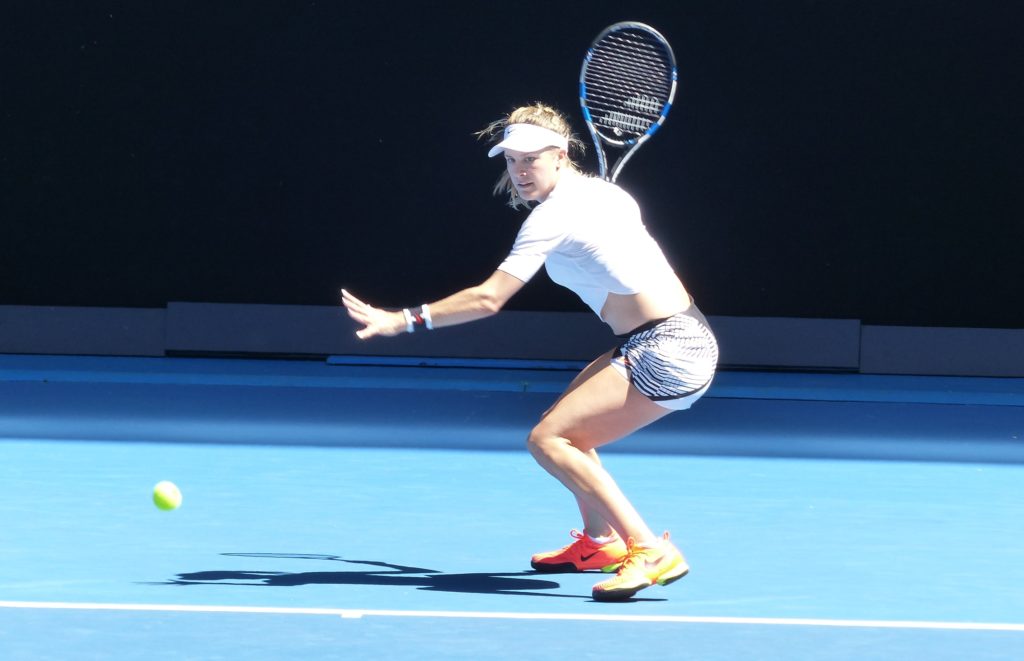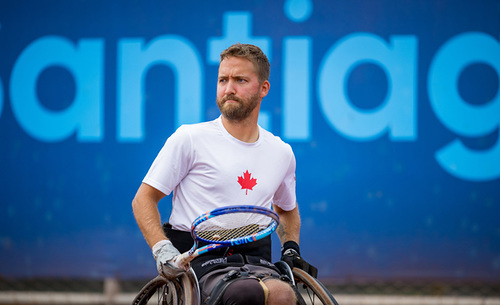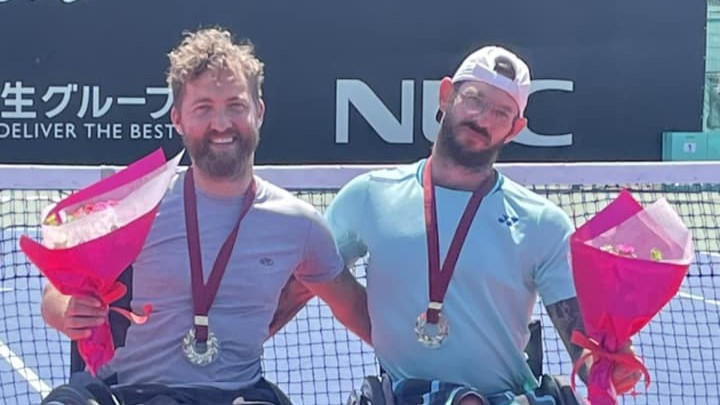
Genie Bouchard has packed a lot of experiences into her past three years on the tour.
There were the highs of two Grand Slam semifinals (Australian and French Opens) in 2014 and a Wimbledon final that same year.
Then there was the drop-off in 2015, dramatically ending with her fall and concussion at the US Open. A year ago, she hoped to put the ‘sophomore jinx’ behind her but stagnated with a ranking that began at No. 48 and had advanced no further than No. 47 by season’s end.
Her fine showing in Sydney last week – beating Zhang Shuai (23), Dominika Cibulkova (6) and Anastasia Pavlyuchenkova (27) all in straight sets before losing 6-2, 6-2 to a lights-out performance by Johanna Konta (10) – was a sign that things were beginning to click.
Then there were two more solid matches so far at the Australian Open – 6-0, 6-4 over No. 65 Louisa Chirico on Monday and 7-6(5), 6-2 Wednesday over No. 83 Peng Shuai.
There was a telling moment during her post-match media conference when she was asked if she had ever played as well last year as she is currently. Her answer said a lot: “No, I feel better with my game now than I have in a while. I think that’s why I was a little bit nervous (against Peng) because I feel like I’m playing well and I could have chances to do well in any match I play. So I therefore put more pressure on myself which leads me to play bad again. So it’s a vicious cycle.”
Bouchard definitely did not “play bad again,” at a critical juncture against Peng. Au contraire, when she faced a crisis point at 4-4 in the first set tiebreak, she reacted exactly the way she would expect herself to – with total commitment, aggressive tennis. After letting a 4-2 advantage slip aided by a feeble double fault into the net, she took matters into her own hands at 4-all and rifled back a forehand service return so hard and deep cross-court that Peng was unable to control her forehand reply.
“I told myself I had to go for more because if I don’t she’s going to do it,” Bouchard said about the thoughts behind that bold ball strike.
From there she hit a backhand winner to 6-4, missed a forehand long to 6-5 and wrapped up the set with a forehand winner down-the-line after forcing Peng wide to her forehand side.
The second set was something of a formality as Bouchard raced out to a 5-1 lead and wrapped up it 6-2 and the match in an hour and 29 minutes.
The 31-year-old Peng, with her double-handed strokes on both sides, had her moments, especially using her dynamic backhand to force Bouchard wide to her backhand.
But once Bouchard began to exploit the weaker forehand side and began to hit out, it was hardly a fair fight.
“I was struggling in the first set,” said Bouchard who admitted to feeling the pressure at the start. “I wasn’t getting up to the ball enough and therefore I was late on a lot of shots which doesn’t allow me to play my game. I freed up a little bit in the second and went for my shots a little bit more, stayed with her more.”

While still not meriting the Main Interview room, Bouchard talked to an array of curious foreign reporters in a crowded Interview Room Two about where she’s at these days after the tumult of the past three seasons that have seen more than a half dozen coaching changes.
“I’m not thinking about the past anymore – the good results, the bad results,” she insisted. “I’m tired of talking about it. I’m tired of thinking about it. For me it’s just about right now and looking forward and trying to be a better player. Trying to be a better player than I was at my best a couple of years ago because everyone improves with every year. So I don’t want to be how I was in 2014 – I need to be better than that right now.”
The future, particularly the immediate future looks bright and full of possibilities at this Australian Open. She plays the uber-erratic No. 35 Coco Vandeweghe on Friday for a spot in the round-of-16. That would likely be against top-seeded Angelique Kerber who has looked remarkably shaky in winning her first two matches in three sets. Beyond that there could be No. 7 Garbiñe Muguruza, who is carrying a leg injury issue, in the quarters and possibly No. 8 Svetlana Kuznetsova, No. 11 Elina Svitolina or No. 13 Venus Williams in the semifinals. None of those players would be beyond Bouchard’s reach given her current form.
“I find it very hard to set goals with specific times,” the No. 47-ranked Bouchard replied to a question about what she’s hoping for in 2017, “but obviously my first goal is to get back in the top-20 whenever I can. I told myself I wouldn’t put expectations on myself for the first couple of months because in the past when I’ve done that I’ve put a lot of pressure on myself and not enjoyed playing.
“Yeah, I think my game and with how I play, I definitely feel I can be back up there. I don’t know when though.”
Her high was No. 5 in October 2014, and maybe except for reaching the Aussie Open quarter-finals two years ago, she has never looked as confident and comfortable as she does at the moment.

There’s also the Australia effect working for her – many Bouchard fans Down Under including the vocal “Genie Army” pictured above.
There was a record day session crowd of 51,767 on Wednesday, with 10,500-seat Hisense Arena, the second biggest on-site behind Rod Laver, filled for the Bouchard – Peng encounter.
“Hisense was almost full, so it was really special and cool to play there,” Bouchard said. “I felt that in my first round as well. I feel that every time I come to Australia. I get some extra love here…and it’s so nice.”
With the win over Peng, she has extended her record for a Grand Slam tournament to 12-3 at the Australian Open and she will be hoping to increase that with the help of more crowd support on Friday.
CANADIAN DOUBLES

Vasek Pospisil and Radek Stepanek, seeded 12th, were knocked out of the 2017 Aussie Open doubles in the first round on Wednesday – beaten 6-2, 6-4 by Australian wild cards Matthew Barton and Matthew Ebden.
“It was a windy day, we were playing a couple of Aussie guys and we had a bad start,” Pospisil said. “I wasn’t playing my best doubles out there.
“We were expecting Barton to serve well and Ebden to be moving a little bit at the net but it was more from our side of the court. We didn’t execute.”
Stepanek, who was runner-up with Daniel Nestor at last year’s Australian Open, was similarly succinct in his assessment of what happened. “Just a horrible day at the office,” the 38-year-old Czech said. “It was windy, breezy and it was hard to find the rhythm for us.”
Asked about his plans now, the 26-year-old Pospisil said, “I’m not 100 per cent sure but most likely we’ll go to the Maui (Hawaii) Challenger next week before Davis Cup (vs. Great Britain Feb. 3-5 in Ottawa) and then stay in the States and play a couple of Challengers, a couple of ATPs, kind of mix and match.”

The news was better for Gabriela Dabrowski and her partner Michaella Krajicek of the Netherlands as they defeated Oksana Kalashnikova of Georgia and Aleksandra Krunic of Serbia 6-4, 6-0.
They will now play the winner of a first-round which has seventh seeds Karolina Pliskova and Julia Goerges matched against Andrea Klepac of Slovenia and Maria Jose Martinez Sanchez of Spain. The 34-year-old Martinez Sanchez was Dabrowski’s partner last year.
Daniel Nestor and Edouard Roger-Vasselin, seeded eighth, will play their opening round on Thursday – third match on Court 15 at about 2 p.m. (roughly 10 p.m. to midnight ET in Canada on Wednesday). Their opponents are Argentines Andres Molteni and Diego Schwatzman.
MILOS–MULLER MEET IN ROUND TWO

Milos Raonic was having a little fun during his practice session last Saturday – whacking balls high in the air, like baseball pop-ups, and seeing if members of his team could catch them. They didn’t have much success.
But it will be all business when he takes on No. 28-ranked Gilles Muller of Luxembourg third match Thursday on Margaret Court Arena (approx 11 p.m. to midnight ET in Canada on Wednesday).
The two have played twice, with Muller winning on both occasions. But there are certainly caveats – the first one was in the second round of Wimbledon in 2011 when Raonic fatefully injured his right hip and had to stop leading 3-2 after five games. The second was in Valencia at the end of 2012 when Raonic was far from the finished product he is today.
But the 33-year-old Muller is coming off his first ATP title in Sydney last week, made especially memorable because his two sons – five-year-old Lenny and four-year-old Nils – were there and likely a big reason for papa’s free-flowing tears during the trophy presentation.
“He had a great, phenomenal week last week,” Raonic said on Tuesday about the left-handed Muller. “For him it was something very special, and obviously it was pretty special to see – that final and his reaction to it.
“I’ve got to take care of my own end of the court, serve well and try to create some opportunities on his. It’s going to be a more predictable match than today but I’ll have to step up and take it to him rather than expect him to give it to me.”
Muller, who made great progress with his former British coach Jamie Delgado, who has now worked with Andy Murray for the past year, is a solidly-built guy who sort of barrels into the net and puts pressure on his opponent. His breakthrough win was 11 years ago at the 2005 US Open when he upset then No. 3-ranked Andy Roddick in a first-round night match.
AUSTRALIA POST CARD

The police in Melbourne don’t need a paddy wagon – unless the load is too big. There’s a convenient little lock-up right in the back of their vehicles.


